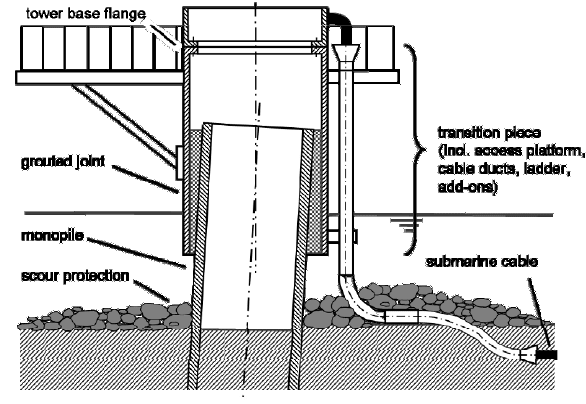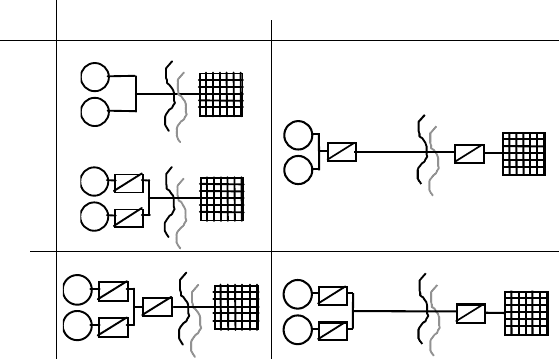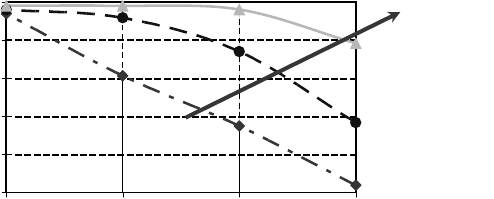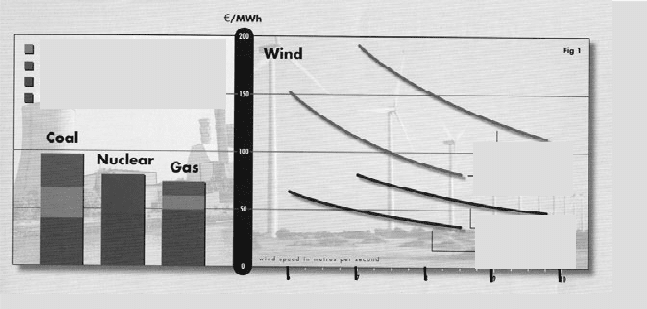Gasch R., Twele J. (Eds.) Wind Power Plants: Fundamentals, Design, Construction and Operation
Подождите немного. Документ загружается.


532 16.4 Support structures and marine installation
sites where high ice loads and particular soil conditions prevail. For other sites,
such devices are more expensive. Dismantling and depositing might reduce the
prospects for future use as observed recently in the oil and gas industry. Floating
offshore wind turbines have been proposed for water depth of larger than ap-
proximately 50 m but are unlikely to materialise in the medium term because of
the extraordinarily high costs for the moorings and the complex dynamic behav-
iour.
Fig. 16-10 Grouted joint (steel-grout-steel hybrid compound) of a monopile foundation between
transition piece and pile as balancing connection
To reduce the high cost, the design must be optimised with respect to a particular
turbine, local site conditions, batch size and the particularities of offshore wind
energy. The dynamic characteristics of the support structure are of particular im-
portance to offshore design. With this in mind, a compromise between the oppos-
ing requirements of the wind energy and offshore communities has to be found.
Wind turbine towers in the megawatt class are slender and flexible structures with
a first natural frequency below 0.45 Hz. Common offshore structures of the petro-
leum industry employ a significantly higher natural frequency since dynamic wave
loading is strongly reduced for structural frequencies above approx. 0.4 Hz. Most
designs for multi-megawatt turbines will be governed by aerodynamic fatigue or
by a combination of aerodynamic and hydrodynamic fatigue. Sophisticated design
approaches are required which integrate the experience from both the offshore oil
and gas industry and the wind energy community [2].
Scarce equipment, high mobilisation costs, weather delays and safety require-
ments make any offshore operation very expensive and logistically complicated.

16 Offshore wind farms 533
Custom-built installation vessels are able to transport and install pre-assembled
modules in short time (Fig. 16-9). Another installation technique, illustrated in
Fig. 16-10, involves a grouted joint between a driven monopile and a transition
piece, with the tower base flange, service platform and other add-ons. With this
construction, damage to the pile top and pile inclination from hammering can be
quickly and easily compensated for.
16.5 Grid connection and wind farm layout
Integrating thousands of megawatts of (offshore) wind energy into the electricity
system will present a great challenge to the transmission grid. In many countries,
the present power system is dominated by centrally located, large-scale plants.
Massive development of offshore wind power will lead to considerably greater pe-
riodic imbalances between production and consumption in the future. For reasons
of operational security, a balance must be struck at any given time of day between
production, exchange with countries abroad, and consumption. This means that
other elements in the electricity system, e.g. biomass or pump storage power sta-
tions, will have to regulate the capacity variations. Wind farms will have to pro-
duce power on demand at variable feed-in prices. Reliable prediction of wind en-
ergy generation within a 24 hour and shorter window is therefore important and
can result in a significant price bonus.
Connection to shore
AC DC
AC
[Ia]
G~
G~
[Ib]
G~
G~
~
~
~
~
[III]
G~
G~
~
_
_
~
Internal connection
DC
[II]
G~
G~
~
_
~
_
_
~
[IV]
G~
G~
~
_
~
_
_
~
Fig. 16-11 Basic options for grid connection
The actual techniques for offshore power collection, transmission to shore, and
grid connection are more straight-forward. Fig. 16-11 presents the basic options.
534 16.6 Operation and maintenance
The main choice for shore connection is either AC or DC transmission. AC trans-
mission involves high dielectric losses (the isolation material acts as a capacitor).
These losses are proportional to the cable length and the voltage. On the other
hand, DC transmission requires expensive converters. For short distances, AC
transmission is most cost effective. The use of DC depends on the component
costs, and usually becomes more economical at distances of 60 km. High-voltage
DC transmission systems have increasingly been used in recent years to transport
electricity from remote energy sources to the distribution grid.
With regard to power collection, the choice is once again between AC and DC.
The first two options in Fig. 16-11, (Ia and Ib) are the ones commonly used for
both onshore and offshore farms. Option II can be found rarely and only onshore.
Option III, which combines an AC coupling of the wind turbines with a DC con-
nection to shore, may cause stability problems in the 'AC island'. The pure DC
technology system in Option IV is elegant, but practical only if reasonably priced
equipment for direct DC voltage transformation becomes available.
Although the sea seems to offer infinite space, wind farm layout still needs to
be carefully considered. Shipping routes, conservation areas, visual impact and lo-
cal variations in water depth (e.g. sandbanks), restrict the area actually available
for development. Theoretically, turbine spacing greater than 10 rotor diameters
(D) apart is optimal when only cable lengths and wind farm losses are taken into
consideration. In practice, however, spacing is only slightly wider than on land: 6
to 8 D in the prevailing wind direction and 4 to 6 D perpendicular to the prevailing
direction.
16.6 Operation and maintenance
The operation and maintenance requirements are crucially important in the context
of the overall cost effectiveness of offshore wind energy. Poor performance and
low availability can jeopardise an offshore wind farm. Two factors that distinguish
offshore sites from onshore sites are the reduced accessibility during bad weather
conditions (resulting from unfavourable waves, winds, visibility and sea ice) and
the costs of transport or lifting operations.
The demonstration offshore wind farms in sheltered waters have availability
rates that approach those of onshore sites. Unfortunately, this positive data is not
representative of real offshore conditions. Therefore in the scope of the Opti-
OWECS project the operational and maintenance scenarios for large wind farms at
remote offshore sites were analysed by Monte-Carlo simulations that took random
failures and weather conditions into account [5, 6]. Although the analysis was
made some years ago its results are qualitatively confirmed by the experience with
the first large offshore wind farms.

16 Offshore wind farms 535
As a qualitative illustration, the wind farm availability is shown as a function of
the percentage of time that turbines are accessible on the horizontal axis and for
three reliability levels in Fig. 16-12. In this case, reliability is defined as the mean
time between failures. Reliability data for the state-of-the-art curve were derived
from a large database of statistics from 500/600 kW-class turbines. The improved
reliability level can be achieved with existing technology, but extra expenses will
be incurred from higher specifications, redundant components and dedicated
O&M strategies. Highly improved reliability can be achieved in several years
through the development and testing of innovative technology.
A site without accessibility restrictions (i.e. onshore) reaches 97% availability
for a state-of-the-art design, increasing to 99% for an extremely reliable design
with an adequate maintenance strategy. This small difference in offshore availabil-
ity requires a major effort to reduce the number of failures and caused downtime
by a factor of four or higher. As weather conditions get worse, availability may
fall anywhere from 50% to 80% depending upon the failure rate and the mainte-
nance approach.
50%
60%
70%
80%
90%
100%
40 % (remote
offshore)
60 %
(offshore)
80 %
(nearshore)
100 %
(onshore)
Availability
Reliability
Accessibilty
state-of-the-art
improved
highly improved
Fig. 16-12 Wind farm availability as function of the reliability of the wind turbine design for
sites with different accessibility
16.7 Economics
Existing projects and various studies suggest a promising future for offshore wind
energy developments. Nonetheless, the “gold rush” spirit prevalent at the begin-
ning of this century has disappeared since it has become obvious that the genera-
tion of wind energy offshore is significantly more expensive than wind energy at
good sites on land. However, the prospects of building large-scale offshore wind
power plants and the more favourable wind conditions make such investments an
interesting option for large players in the power business. Typical offshore capacity
536 16.7 Economics
factors (full load equivalences), i.e. the ratio of average generated power and rated
power, range from 30% to 40%, while a capacity factor of only approx. 25% is
currently achieved on land.
Information about the actual costs of commercial offshore projects is hardly avail-
able. Table 16.1 compares the specific investment cost in €/kW and the specific
cost of energy in €/kWh, i.e. the ratio between total investment and annual energy
yield. On the one hand, a significant cost decrease is observed with respect to the
first demonstration projects in the beginning of the 1990s. On the other hand, costs
have increased again in recent years caused by the more exposed sites at larger
water depths and larger distance to shore. Obviously, projects in the sheltered
Baltic like Middelgrunden, Nysted and Lillgrund are less expensive than installa-
tions in the North Sea.
Typical relative cost contributions of an offshore wind farm with 5 MW
machines are listed in Table 16.2. The absolute cost of the rotor-nacelle assembly
and the tower are hardly affected by the site and project conditions. Obviously, the
relative contribution of turbine cost fluctuates between a third and a half of the
total project cost. The share of the foundation and grid connection and the soft
costs for planning and project realisation can be up to twice the share of the rotor-
nacelle assembly. In contrast, such project costs account only for 25-30% of the
effort for the wind turbine ex-works on land. The present example shows only
little variation in foundation costs since only one particular foundation type at
large water depth is considered here. The cost of the grid connection is mainly
influenced by the distance to shore and onshore grid connection.

16 Offshore wind farms 537
Table 16.1 Cost comparison of actual build offshore wind farms [7]
Project,
site
& country
Year of
installation
Power [MW]
Investment cost [M€]
Annual
energy yield [GWh]
Spec.
investment [€/kW]
Spec. Cost of energy
[€/kWh/a]
Vindeby, Baltic, DK 1991 4.95 10 11.2 2,020 0.89
Tuno Knob, Baltic, DK 1995 5 10 15 2,000 0.67
Middelgrunden, Baltic, DK 2000 40 50 99 1,250 0.51
Horns Rev, DK 2002 160 270 600 1,688 0.45
Samsø, Ostsee, DK 2002 23 32 80 1,391 0.40
Nysted, Baltic, DK 2003 165.6 250 480 1,510 0.52
Arklow Bank, IRL 2003 25.2 50
N
aN 1,984
N
aN
North Hoyle, UK 2003 60 110 200 1,833 0.55
Kentish Flats, UK 2005 90 156 285 1,733 0.55
Burbo Bank, UK 2007 90 150 315 1,667 0.48
Lillgrund, SE 2007 110.4 167 300 1,513 0.56
Q7, NL 2007/2008 120 383 435 3,192 0.88
Table 16.2: Typical cost break-down of an offshore wind farm with 5MW
wind turbines [8]
Component Approx. cost share
Rotor-nacelle assembly incl. transformer, switch gear 33-50% *)
Tower 5%
Foundation (tripod) 15-18%
Foundation piles (site specific) 2-6%
Offshore installation (incl. weather risk) 5-7%
MV submarine cables (within cluster) 2%
HV submarine cables (shore connection) 2 - 20%
Offshore sub-station 4-10%
Onshore grid connection 4-10%
Planning, certification, due diligence 4-7%
Financing incl. interim financing 3-6%
*) actual contribution depending on amount of total project
costs

538 16.7 Economics
Annual average wind speed (hub height)
6 7 8 9 10 m/s
€/MWh
200
150
100
50
0
Cost of Carbon (ETS)
Cost of Carbon (Stern)
Range
Base Price
Offshore
2.600 €/kW
2.300 €/kW
Onshore
1.500 €/kW
1.100 €/kW
Annual average wind speed (hub height)
6 7 8 9 10 m/s
€/MWh
200
150
100
50
0
Cost of Carbon (ETS)
Cost of Carbon (Stern)
Range
Base Price
Offshore
2.600 €/kW
2.300 €/kW
Onshore
1.500 €/kW
1.100 €/kW
Fig. 16-13 Comparison of cost of electricity generation between newly installed conventional
power plants and onshore and offshore wind farms [Windpower Monthly 1/2008]
The electricity generation cost for different power sources including financing and
operation and maintenance costs are presented in Fig. 16-13. Increasing prices for
raw materials like steel and copper as well as the high demand for wind turbines
have caused an increase in wind farm costs of up to 30% during recent years. Even
taking this into account, wind energy at good sites on land is cost competitive with
newly installed conventional power plants. Offshore the specific investment costs
in €/kW are about twice as high as onshore. Therefore, the higher energy yield of
sea-based plants cannot compensate the larger investment and running costs.
Typically, generation costs offshore are 50-100% higher than on land. Hence, fur-
ther technological development and economy of scales are badly needed to im-
prove economic viability.
Despite these disillusioning economic facts, the necessity to reduce carbon di-
oxide emissions and fossil fuel consumption results in political incentives to foster
the future large-scale exploitation of offshore wind resources. The German Energy
Feed-in Law (2009) grants a feed-in tariff which is twice as high offshore as for
good onshore sites. Depending on the water depth and distance to shore the power
purchase price range is 10-11 ct/kWh. In addition, the considerable cost for con-
necting offshore wind farms to the grid on land have to be covered by the trans-
mission system operator (TSO) if the installation activities are started before the
year 2012. This corresponds to an additional incentive of approx. 30% of the gen-
eration cost. Every European country operates a slightly different incentive sys-
tem. Surprisingly, this is more driven by political considerations than by the actual
natural resources and site conditions. For instance, in the United Kingdom the in-
stallation of new wind farms on land is difficult in the southern part of Britain due
to lack of public acceptance, among other reasons. The exploitation of the enor-
mous offshore wind resources is however booming because of both considerably
16 Offshore wind farms 539
higher feed-in tariffs and the much more favourable site conditions with lower
water depths, shorter distances to shore and higher annual average wind speeds
compared to other European countries.
References
[1] Matthies, H., et al.Study on Offshore Wind Energy in the EC (JOUR 0072), Verlag
Natürliche Energien, Brekendorf, 1995
[2] Kühn, M., Dynamics and Design Optimisation of Offshore Wind Energy Conversion
Systems, Doctoral Thesis, Delft Univ. of Technology, 2001
[3] EWEA, Delivering Offshore Windpower in Europe, European Wind Energy Associa-
tion (EWEA), Dec. 2007
[4] Barltrop, N.D.P., Adams, A.J., Dynamics of Fixed Marine Structures, 3
rd
ed., Butter-
worh-Heinemann Ltd., Oxford, 1991
[5] Ferguson, M.C. (ed.), Kühn, M., et al., Opti-OWECS Final Report Vol. 4: A Typical
Design Solution for an Offshore Wind Energy Conversion System, Delft Univ. of
Technology, 1998
[6] van Bussel, G.J.W.; Development of an Expert System for the Determination of
Availability and O&M Costs for Offshore Wind Farms, Proc. EWEC 1999, 402 - 405
[7] http://www.offshorecenter.dk/offshorewindfarms.asp, accessed 20/11/2008
[8] de Buhr, I., Darstellung der Kostenblöcke bei Offshore-Windenergieprojekten,
Vortrag Husum Wind 2007.
R. Gasch and J. Twele (eds.), Wind Power Plants: Fundamentals, Design, Construction 540
and Operation, DOI 10.1007/978-3-642-22938-1, © Springer-Verlag Berlin Heidelberg 2012
Index
A
AC machine, rotor type 383
AC-DC-AC conversion 398
AC-DC-AC converter 438
Active current 368
Active plane 168
Active power 369, 378, 389, 471
- production 472
Active stall 410
Actuator 412
Aerodynamic brake 58
Aerodynamic damping 267, 298
Aerodynamic force 180, 259, 260
Aerodynamic load 276
Aerodynamic manipulation measure 405
Aerodynamic unbalance 279
Aeroelastic problem 299
Airfoil theory 175
Airy-wave theory 522
Alignment of blade section 203
Alternating load 149
Alternator 364, 376
Analysis concept 312
Analysis procedure 307
Anemometer 156
- Cup ~ 156
- Ultrasonic ~ 156
- Propeller ~ 156
- heated ~ 89
Angle of attack 40, 175
Angle of relative velocity 198
Annual energy yield 512, 516
Annual operating costs 495
Annual yield versus wind speed 514
Approval process 484, 486
Archimedean screw 20, 341
Assembly 103
Asynchronous generator 384, 453
Atmospheric boundary layer 118
Atmospheric stability 125, 155
Atmospheric stratification 124, 161
Attached flow 241
Available cash 509
B
Baltic Sea 522
Battery charger 444
Bending stress 261
- due to weight 264
Bernoulli 335
Betz 29, 168
- optimum blade dimension 181
-constant turbine 516
Blade 221
- analysis 324
- angle pitching 411
- bearing 66
- chord 183
- design 324
- eigenmode 290
- element momentum method 208
- element theory, limits 240
- geometry 168
- heating 89
- mass 271
- natural frequency 290
- passage 281
- pitch system 66
- production 327
- resonance diagram 291
- response 292
- root load 150
- section 54
- tip speed 77
- transportation 499
- twist 185
- vibration 289
- weight 58
Boosting unit 397
Boundary layer 247
Brake 84
Braking system 84
Buckling 317
C
Calms statistic 135
Campbell diagram 289
Capacitor 366
Capture matrix 304
Carbon fibre 55
Cash reserve 509
Centrifugal force 259, 275
Centrifugal governor 412
Centrifugal pump 336, 345, 346
- design 359
Index 541
- H-Q diagram 346
Certification 151, 307
- calculation 303
CFD- Computational fluid dynamics 246
- application to wind turbines 248
-grid 247
Chain pump 341
Chinese windmill 16
Chord length 175
- dimensionless ~ 197
Circumferential force 210
Coherence function 140
Commissioning 503
Comparison lift and drag based rotors 42
Comparison of wind pump systems 345
Comparison of wind turbine concepts 441
Comparison of wind turbines 512
Complex terrain 151
Component failure 327
Components of wind turbines 46
Computational fluid dynamics - CFD 246
Concepts of electricity generation 428
Condition monitoring system 506
Consumer control system 451
Continuity equation 335
Control by aerodynamic forces 422
Control by centrifugal forces 421
Control by wind pressure 418
Control power 467
Control strategy 415
Control system 400, 413
Controller design 416
Controller type 414
Conversion of wind energy 331
Converter 397
Cooling 89
Coriolis force 114
Correlation coefficient 165
Costs for a wind farm project 496
Costs for maintenance 496
Costs for repair 496
Costs for replacement 496
Coupled blade-drive train system 296
Coupling 84
Crane 501
Critical section plane 322
Cross spectra 140
Cup anemometer 37, 157
D
Daily load profile 465
Damage accumulation 314, 322
Damping coefficient 269
Damping ratio 260, 286
Danish concept 405, 431
Darrieus rotor 17, 40
Day-ahead prediction 465
DC intermediate circuit 439
Decay factor 269, 284
Decommissioning 507
Delta connection 382, 433
Design
- procedure 272, 310
- resistance 314
- tip speed ratio 50, 179, 183, 208, 223
Diaphragm pump 339
Diffraction load 524
Digital simulation 299
Dimensionless turbine characteristics 211
Diode 366, 394
- bridge 395
Discharge volume 334, 351
Distance regulation 491
Distribution grid 461
Doubly-feeding asynchronous
generator 439
Downstream wake rotation 191
Downwind profile 146
Downwind rotors 48
Drag coefficient 36, 175
Drag driven rotor 35, 40
Drag force 40
Drag loading
523
Drainage 330
Drive drain 69, 404
- control 405
- vibration 292
- with gearbox 69
- gearless 72
- modular, integrated 70
Due diligence 307
Dutch smock mill 21, 22
Dynamic slip control 436
Dynamic stall 244
E
Eclipse control 418
Ecological effect 486
Economic efficiency 491, 508
Economics, offshore 535
Eddy slicing 280
Edgewise bending 290
Ekman layer 127
Elastic axis 202
Elastic line 54
Electrical component 365
